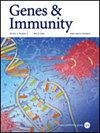Inorganic pyrophosphatase 1: a key player in immune and metabolic reprogramming in ankylosing spondylitis
IF 4.5
3区 医学
Q1 GENETICS & HEREDITY
引用次数: 0
Abstract
The relationships among immune cells, metabolites, and AS events were analyzed via Mendelian randomization (MR), and potential immune cells and metabolites were identified as risk factors for AS. Their relationships were subjected to intermediary MR analysis to identify the final immune cells and metabolites. The vertebral bone marrow blood samples from three patients with and without AS were subjected to 10× single-cell sequencing to further elucidate the role of immune cells in AS. The key genes were screened via expression quantitative trait loci (eQTLs) and MR analyses. The metabolic differences between the two groups were compared through single-cell metabolism analysis. Two subgroups of differentiated (CD)8+ memory T cells and naive B cells were obtained from the combined results of intermediary MR analysis and AS single-cell analysis. After the verification of key genes, inorganic pyrophosphatase 1 (PPA1) was identified as the hub gene, as it is differentially expressed in CD8+ memory T cells and can affect the metabolism of T cells in AS by affecting the expression of ferulic acid (FA)4 sulfate, which participates in the cellular immunity in AS.

无机焦磷酸酶 1:强直性脊柱炎免疫和代谢重编程的关键角色。
通过孟德尔随机化(MR)分析了免疫细胞、代谢物和强直性脊柱炎事件之间的关系,并将潜在的免疫细胞和代谢物确定为强直性脊柱炎的风险因素。对它们之间的关系进行中间MR分析,以确定最终的免疫细胞和代谢物。为了进一步阐明免疫细胞在强直性脊柱炎中的作用,对三名强直性脊柱炎患者和非强直性脊柱炎患者的脊椎骨骨髓血样进行了10×单细胞测序。通过表达量性状位点(eQTLs)和磁共振分析筛选了关键基因。通过单细胞代谢分析比较了两组之间的代谢差异。根据中间MR分析和AS单细胞分析的综合结果,得出了分化(CD)8+记忆T细胞和幼稚B细胞两个亚组。经过对关键基因的验证,无机焦磷酸酶1(PPA1)被确定为中枢基因,因为它在CD8+记忆T细胞中差异表达,并能通过影响硫酸阿魏酸(FA)4的表达来影响强直性脊柱炎中T细胞的代谢,而硫酸阿魏酸参与强直性脊柱炎的细胞免疫。
本文章由计算机程序翻译,如有差异,请以英文原文为准。
求助全文
约1分钟内获得全文
求助全文
来源期刊

Genes and immunity
医学-免疫学
CiteScore
8.90
自引率
4.00%
发文量
28
审稿时长
6-12 weeks
期刊介绍:
Genes & Immunity emphasizes studies investigating how genetic, genomic and functional variations affect immune cells and the immune system, and associated processes in the regulation of health and disease. It further highlights articles on the transcriptional and posttranslational control of gene products involved in signaling pathways regulating immune cells, and protective and destructive immune responses.
 求助内容:
求助内容: 应助结果提醒方式:
应助结果提醒方式:


